The Federal Council’s report on the «Future orientation of rail freight transport in the area» was sent out for consultation. In it, the economic viability of single wagonload transport is presented as impossible without any evidence. As alternatives, the federal government envisages shifting rail freight transport to the road in the medium term or subsidising it permanently. We think: It’s more complicated than that.
That’s the point:
- Two variants and what they do not take into account
- Fundamental reorganisation of the network necessary
- Outsourcing of the last mile central to more competition
The further development of rail freight transport in the country is currently the subject of heated debate. On 2 November 2022, the Federal Council submitted its dispatch on the «Further development of the framework conditions for Swiss freight transport» for consultation. The report suggests that there will be no more single wagonload transport without financial support; block trains will not be subsidised anyway. The Federal Council proposes two options:
- The single wagonload transport in the area is further developed and modernised through digitalisation, automation and the creation of a data exchange platform. Locations that are necessary for successful area service will be better integrated into the spatial planning of the cantons and the federal government. Until the modernisation measures take effect, the single wagonload transportwill be financially supported by ordering the service in the form of investment and operating contributions.
- The single wagonload transport in the area will be discontinued. The rail system will be reduced to block trains, resulting in a massive downsizing of SBB Cargo.
Both variants are supported by the migration to digital automatic coupling (DAK), the promotion of multimodality and Rhine navigation, and the financing of climate-neutral drives on rail and Rhine.
Fundamental reorganisation instead of rhetoric
The single wagonload transport in the area comprises a good 70% of the traffic volume in inland transport by rail. The Federal Council’s question as to whether it should be preserved is therefore rather rhetorical. However, his conclusion that it can be successfully operated by SBB Cargo after modernisation with the help of DAK is not a realistic option either. Rather, the rail freight transport in the area must be fundamentally restructured and opened up to other market players. In this respect, the Federal Council’s report falls far short of the expectations of customers and its own announcements.
Digitalisation and automation will make rail freight transport more efficient and, above all, more interesting for the logistics industry: For the first time, rail freight transport can be integrated online into the logistics chains of the economy and into the train protection of the infrastructure managers. The DAK in conjunction with the state data exchange platform in accordance with the Federal Mobility Data Infrastructure Act (MODIG) is thus THE central lever for the competitiveness of the rail freight transportand success factor number one of this legislative proposal.
However, the single wagonload transport, which has been a monopoly of the SBB since the railway reform in 1999, must be fundamentally restructured. The roles and processes must be completely rethought. This internal renewal requires the involvement of other market players in order to design a service with lower fixed costs and correspondingly higher flexibility. In this respect, the Federal Council falls behind its report of 30 March 2022. While in its diagram there it showed a new interplay of the various players in the rail freight transport system (p. 50/75), in the draft message it merely proposes a continuation of the currently not very successful model of «all services from a single source» of SBB Cargo. Once again, the question of the future viability of a broad range of services in the single wagonload transport in Switzerland is equated with the further development of the state-owned company SBB Cargo.
In fact, customers want a variant 1+. In addition to the digitalisation of rail freight transport and promotional measures for more multimodality, this also includes the reorganisation of single wagonload transport. This includes the neutralisation and financial support of short-distance delivery (last mile), the creation of a neutral digital booking and data exchange platform and the possibility of integrating private wagonload services.
Industry united for big changes
The IG Wagonload Transport interest group calls for an efficient network offer (hub and spoke) with more competition and less discrimination. The Federal Council should take up our common vision of rail freight transport – which, by the way, was supported by the Federal Office of Transport FOT – in the definitive Federal Council message (cf. VAP blog post «Critical view of the federal government’s long-term perspective»). The same applies to the consolidated position of the freight railway managers of the VöV on how the rail freight transport can be operated successfully in the long term in the area (cf. blogpost «Industry develops joint solution»).
The Federal Council expects a common stance from the freight transport industry. It should take a more differentiated look at their joint assessment and the numerous nuances of the rail freight transport in the area when shaping its future and take greater account of them.



